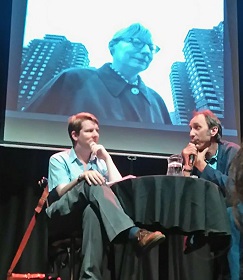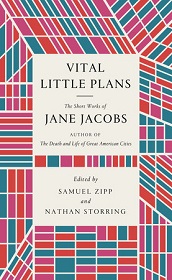Main author
Michael BrooksVital Little Plans - book launch
On 5 July 2017, Designing Buildings Wiki attended the launch event of a new anthology of the urbanist Jane Jacobs' short works 'Vital Little Plans', organised by the Architecture Foundation.
The event, at east London's Hoxton Hall, brought together in conversation two of the built environment's most forthright commentators - the Booker Prize-shortlisted novelist Will Self and the critic/author Owen Hatherley.
Self began by quoting the jazz writer Nat Hentoff - "symbolism and reality are often infused" - and reflected on how he had been thinking about this a lot in light of the Grenfell Tower fire. According to Self, London's architecture is at a "critical point", referring to architecture as "a different kind of art, necessarily social - we can think in terms of there being moral and immoral buildings".
He poured characteristic scorn on the 'pseudo-modernist' (to use Hatherley's neologism) architecture of the neoliberal period, with cheap and ugly cladding, 'barcode' facades and parametricism. The clusters of new tall buildings containing luxury apartments, far from adopting the principle of 'form follows function', were more like 'form follows future productivity' - "which is why they all look so flimsy, they are almost transparent".
"Perhaps Grenfell", Self said, "marks the end of space and place being so commodified that they depart from the very notion of being the built environment at all."
On the subject of Jane Jacobs, Self said she was someone "preoccupied with the city as a unified phenomenon; a sense that we in Britain lack. We have a weary reverence for London, but we admire its innate anarchism, the failure of planners to impose their singular vision on it."
Jacobs' most famous theories - the 'sidewalk ballet', 'eyes on the street', 'guardians and thinkers never meeting' - might now seem hoary, nonetheless said Self, "I can't think of any other urbanist thinker who comes so readily to mind when thinking about the phenomenology of the built environment."
Owen Hatherley - who Designing Buildings Wiki interviewed in 2016 - began by saying we should err away from the tendency to treat Jacobs' work uncritically, and bring it down from its pedestal. With reference to the event's location, he pointed out that Hoxton Lane and Hoxton Street do something that Jacobs says is impossible - a housing project and organic city side-by-side with "awful hipster cafes selling expensive juice", shopping arcade, etc.
Hatherley went on to say that Jacobs' 1961 masterpiece 'The Death and Life of Great American Cities' was indeed an attack on the conventions of built environment and city planning; "It's a composite of Le Corbusier's Cite Radieuse, Ebenezer Howard's garden cities and verdant new towns as 'overspill' from the metropolis, the City Beautiful movement".
He characterised her transformation "from cranky freelancer to urban warrior" as the result of encountering the slum more and more as a reality rather than an abstract concept.
Self took Hatherley to task for trying to peg Jacobs as a Blairite figure, but Hatherley argued, "she was an advocate for neoliberal ideas like privatisation - the idea that the city was made up of guardians and traders who should never meet."
"But", he said, "her critique of Robert Moses and how his meat-axe sought to destroy everything that was good about New York was absolutely correct."
Ever the polemicist, Self countered by saying that "to be fair to Moses, he did at least try and build some new social housing in New York!"
In response to an audience question about the legacy and future of high-rise towers post-Grenfell, Hatherley was unequivocal:
"...anyone who thinks the response to Grenfell is an argument against towers is a moron - that's like arguing that after the King's Cross fire we should stop building railways underground, or that after the Hillsborough disaster we should stop watching football in stadiums."
Those seeking an introduction to Jacobs' theories and ideas, amassed during a career spanning over six decades and including forays into various other fields of interest, would do well to have a look through 'Vital Little Plans'. As well as her most famous 1958 essay 'Downtown is for People', it contains several other lesser-known pieces, all of which draw a fascinating picture of one of the built environment's most influential and inspired thinkers.
'Vital Little Plans: The Short Works of Jane Jacobs' is published by Short Books Ltd. You can purchase a copy here.
[edit] Find out more
[edit] Related articles on Designing Buildings Wiki
- British post-war mass housing.
- Garden cities.
- Gentrification.
- Jane Jacobs and garden villages.
- Last Futures: Nature, Technology and the End of Architecture.
- Owen Hatherley - Landscapes of Communism.
- Owen Hatherley interview.
- Richard Rogers - A Place for all People.
- Social housing.
- The Architecture of Neoliberalism.
- Will Self interview.
Featured articles and news
A change to adoptive architecture
Effects of global weather warming on architectural detailing, material choice and human interaction.
How big is the problem and what can we do to mitigate the effects?
Overheating guidance and tools for building designers
A number of cool guides to help with the heat.
The UK's Modern Industrial Strategy: A 10 year plan
Previous consultation criticism, current key elements and general support with some persisting reservations.
Building Safety Regulator reforms
New roles, new staff and a new fast track service pave the way for a single construction regulator.
Architectural Technologist CPDs and Communications
CIAT CPD… and how you can do it!
Cooling centres and cool spaces
Managing extreme heat in cities by directing the public to places for heat stress relief and water sources.
Winter gardens: A brief history and warm variations
Extending the season with glass in different forms and terms.
Restoring Great Yarmouth's Winter Gardens
Transforming one of the least sustainable constructions imaginable.
Construction Skills Mission Board launch sector drive
Newly formed government and industry collaboration set strategy for recruiting an additional 100,000 construction workers a year.
New Architects Code comes into effect in September 2025
ARB Architects Code of Conduct and Practice available with ongoing consultation regarding guidance.
Welsh Skills Body (Medr) launches ambitious plan
The new skills body brings together funding and regulation of tertiary education and research for the devolved nation.
Paul Gandy FCIOB announced as next CIOB President
Former Tilbury Douglas CEO takes helm.
UK Infrastructure: A 10 Year Strategy. In brief with reactions
With the National Infrastructure and Service Transformation Authority (NISTA).
Ebenezer Howard: inventor of the garden city. Book review.
Airtightness Topic Guide BSRIA TG 27/2025
Explaining the basics of airtightness, what it is, why it's important, when it's required and how it's carried out.

























Comments
I don't believe Hatherley can have read Jacobs' book "The life and death of American Cities". Jacobs was extremely critical of Ebenezer Howard and the garden city idea as well as of Le Corbusier's vision. Her premise was much more based on observation of human behaviour and concerned with the building of local communities with diversity of shops, restaurants, convenience stores, creches, local community amenities all within easy walking distance of residential clusters. Howard and Corb envisioned something requiring urban sprawl or were in thrall to the motor car - walking, local encounters, meeting points were hardly their reference points. Jacobs is hugely relevant now in promoting local diversity and community integration. Professional planners and developers seem to forget these basics time and again unless they are truly concerned with place making as opposed to "quick buck" making.